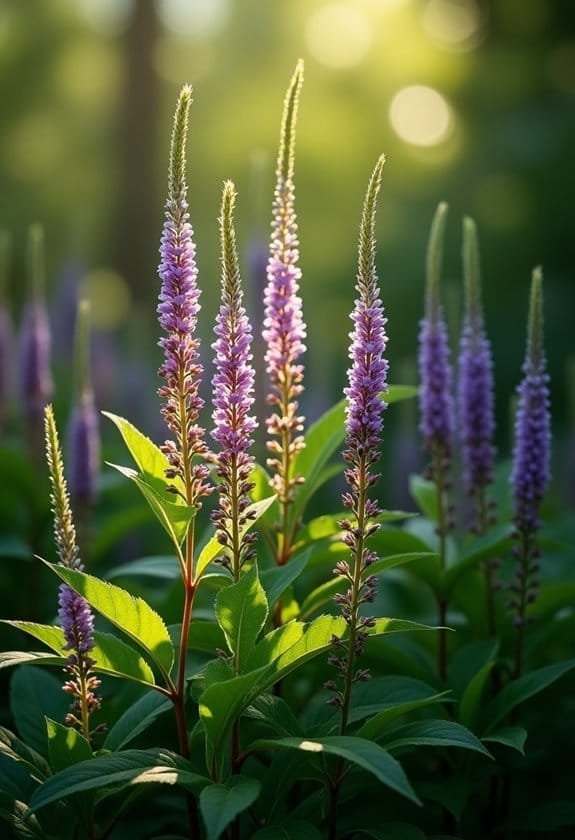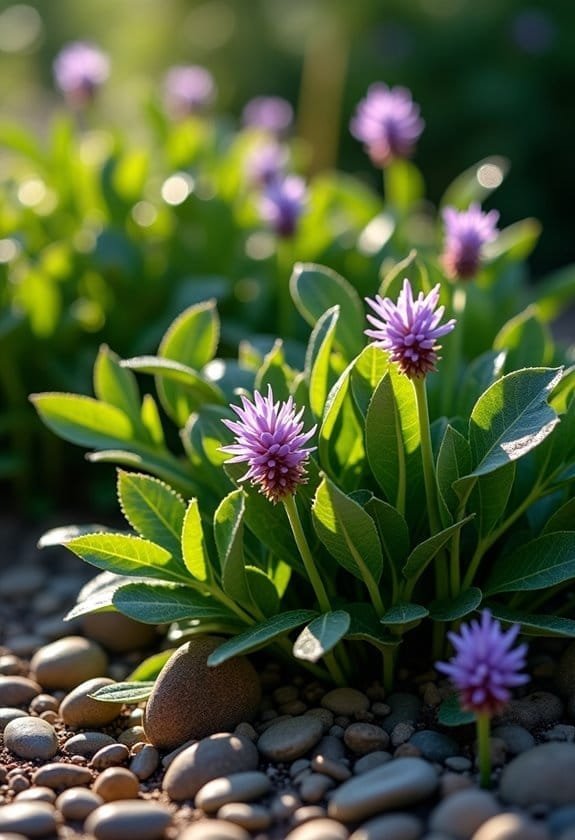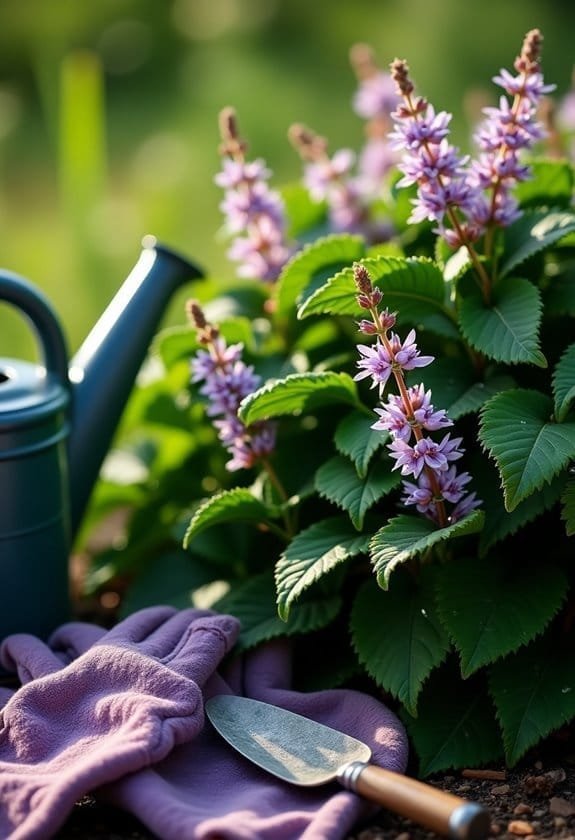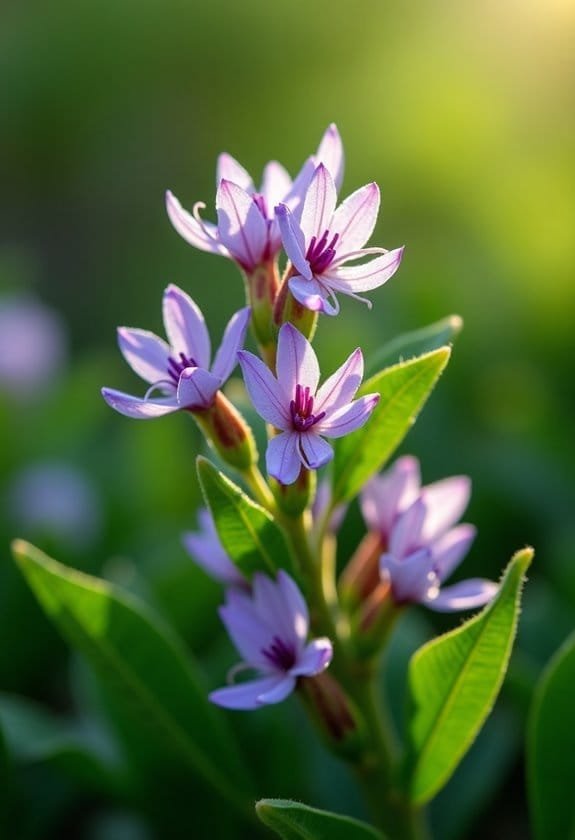The *Hebe* species, now classified under the genus *Veronica*, includes over 100 varieties primarily found in New Zealand, thriving in well-drained, sunny environments. These hardy plants, reaching heights from 30 cm to 2 m, exhibit striking leathery leaves and vibrant flower spikes from late spring to autumn. Their adaptability allows them to flourish in various ecosystems, attracting significant pollinators like bees and butterflies with their beautiful blooms. Proper care maintains their health, requiring full sunlight, regular hydration, and well-drained soil. By nurturing these remarkable plants, cultivators enhance garden biodiversity and aesthetics, leading to even greater insights into their fascinating characteristics.
Main Points
- The genus *Hebe*, now reclassified as *Veronica*, includes over 100 species primarily from New Zealand.
- *Hebe* is characterized by vibrant flowers, thriving in sunny, well-drained environments and hardy in USDA zones 7 and 8B.
- Flowering occurs from late spring to early autumn, attracting pollinators like bees and butterflies, enhancing ecological interactions.
- Varieties display diverse growth habits and require at least six hours of full sun daily with well-drained soil for optimal health.
- The Hebe Society promotes conservation and genetic diversity through hybridization and cultivator collaboration, fostering awareness and best practices.
Introduction

Hebe species, now recognized under the genus *Veronica*, are commonly referred to as hebe or shrubby veronica.
This diverse group encompasses over 100 species, each characterized by unique foliage and vibrant blooms that grace gardens during the summer and autumn months.
With origins tracing back to New Zealand, these plants thrive in sunny, well-drained environments, making them a beloved choice for gardeners seeking both hardiness and aesthetic appeal.
Common Name
Known as shrubby veronicas, Hebe species are cherished for their striking evergreen leaves and vibrant blooms that display a spectrum of colors, including white, pink, purple, and blue.
These lovely flowers not only enhance garden aesthetics but also attract a variety of pollinators, contributing to biodiversity. With over 100 distinct Hebe species, their versatility shines through in the diversity of heights, leaf shapes, and flower colors, making them suitable for numerous landscape designs.
Primarily hardy in USDA zones 7 and 8B, Hebes can thrive in varied climates. While hardy varieties flourish in regions like Portland, more tender types prefer milder winters to thrive.
The flowering period for these plants generally spans from late spring to early autumn, peaking during the summer months, although temperature fluctuations and local conditions can impact blooming intensity.
Notable cultivars such as Hebe Caledonia, Champion, and Karo Golden Esk stand out for their aesthetic appeal and adaptability.
These varieties not only elevate garden beauty with their rich colors but also demonstrate resilience, allowing gardeners to enjoy an extended flowering season while fostering vibrant outdoor spaces.
Scientific Name
The scientific naming of these stunning plants falls under the genus *Hebe*, which has recently been reclassified within the larger genus *Veronica*. This reclassification reflects ongoing research into the relationships among over 100 species originally hailing from New Zealand and its surrounding regions.
The distinctive characteristic of *Hebe* species lies in their unique leaf arrangements, typically formed in four perpendicular rows of opposite, decussate pairs.
The flowers are equally remarkable, displaying perfect structures typically comprising a corolla with four slightly unequal lobes and two stamens arranged in attractive spikes, contributing to their ornamental appeal. The *Hebe* varieties thrive across various ecosystems, from coastal areas to alpine environments, showcasing adaptability through significant leaf size variation according to altitude.
Several cultivars, including *V. albicans* and *Blue Clouds*, have garnered prestigious recognition, receiving the Royal Horticultural Society's Award of Garden Merit due to their exceptional ornamental value and resilience.
This classification not only enhances the understanding of *Hebe* species but also highlights their ecological significance and aesthetic contributions to gardens and landscapes.
Overview
What makes Hebe species so intriguing? These evergreen shrubs, often categorized within the broader genus *Veronica*, attract gardeners with their vibrant flowers in summer, adding life and color to any landscape.
With over 100 species, Hebe varieties show remarkable diversity, boasting an array of flower colors—from pristine white to vivid purple and luscious blue—each contributing to their aesthetic appeal.
These hardy plants typically thrive in USDA Zone 7, demonstrating impressive cold tolerance among various species and cultivars. They flourish in well-drained soil, thriving in full sun to partial shade, making them ideal for coastal gardens and sunny borders.
The adaptability of Hebe underlines its prominence as an ornamental choice, with several cultivars earning the esteemed Royal Horticultural Society's Award of Garden Merit.
Moreover, their unique leaf shapes and sizes add textural interest throughout the year, keeping gardens looking vibrant even during the colder months.
As practitioners recognize their resilience and beauty, the allure of Hebe continues to grow, inviting both seasoned horticulturists and newcomers to explore its intriguing potential in diverse gardening scenarios.
Key Features
Hebe species encompass a diverse range of sizes, from compact varieties reaching just 30 centimeters to taller forms that can grow up to 2 meters in height.
Their striking appearance is marked by ornamental, leathery leaves and vibrant flower spikes, blooming from late spring through early autumn in hues of white, blue, and purple.
This growth pattern not only enhances the visual appeal of gardens but also fosters a rich environment for pollinators like butterflies and bees, showcasing their ecological significance.
Growth Size
Many Hebe species showcase a remarkable range in growth size, making them versatile choices for diverse garden designs. Compact dwarf shrubs, such as *H. pinguifolia* varieties, typically grow only 0.1 to 0.5 meters tall, perfect for smaller spaces or rock gardens. Notable examples include *H. Wiri Cloud* and *H. Wiri Charm*, both achieving a maximum height of 0.5 to 1 meter while exhibiting a lush, bushy habit that enhances any landscape.
In contrast, larger varieties like *H. × andersonii* can reach impressive heights of 1.5 to 2.5 meters, renowned for their abundant summer and autumn blooms. This contrast in growth size creates ample opportunities for gardeners to incorporate both low-growing and towering specimens in their designs.
Additionally, the growth habit of Hebe species varies dramatically; some varieties spread as mat-like ground covers, while others adopt a more upright or bushy form.
Appearance
Distinctive features characterize Hebe species, making them easily recognizable in gardens and landscapes. These remarkable plants typically exhibit four rows of leaves, arranged in opposite decussate pairs, contributing to their striking aesthetic. The leaves themselves vary in size and shape, often influenced by altitude and habitat.
With over 100 species, the diversity can be quite remarkable, ranging from small, oblong forms to wider, more rounded types.
Hebe flowers are another enchanting aspect of their appearance. Each flower is perfect, featuring a corolla composed of four slightly unequal lobes, with two visible stamens that add to their allure. These blossoms are arranged in spikes, an inflorescence structure that can make species identification challenging during periods when they're not in bloom.
The size of Hebe plants adds to their inclusive appeal, ranging from dwarf shrubs to small trees, some species reaching impressive heights of up to 7 metres (23 feet). The combination of unique leaves and attractive flowers creates a visual spectacle, ensuring that Hebe species effortlessly draw attention in any garden design.
Flowering Season
Typically, Hebe species showcase an impressive flowering season that spans from late spring to early autumn, with their peak blooms occurring in the vibrant summer months. During this time, many varieties produce delightful clusters of white flowers, alongside a stunning array of colors, such as blue, pink, and purple, creating a visual feast for garden enthusiasts.
The intensity and duration of flowering can greatly vary among different Hebe species and cultivars, largely influenced by climate and local growing conditions. For instance, varieties like Hebe Caledonia and Hebe Champion are well-regarded for their abundant blooms, while the unique Hebe Pretty in Pink features shorter flower spikes that bloom from July to October, offering a distinct aesthetic.
However, growers should be wary of the potential for cold weather to disrupt flowering patterns. Many Hebe varieties exhibit sensitivity to frost, which can hinder their blooming success in colder climates.
Understanding these dynamics allows gardeners to select appropriate species for their environments, ensuring a picturesque display during the blooming season. Fundamentally, appreciating the diverse flowering behaviors of Hebe species is essential for cultivating a spectacular summer garden.
Growing Requirements

Hebe species flourish best under full sun exposure, demanding at least six hours of bright light each day to achieve ideal health and vibrant growth.
They thrive in well-drained soils, exhibiting versatility by adapting to a range of pH levels, from neutral to alkaline, while also preferring textures such as chalk, loam, and sand.
Regular hydration is essential, especially for young plants, as they require consistent moisture during dry spells to prevent stress and guarantee robust development.
Light
When it comes to light requirements, Hebe species flourish best in full sun, thriving on several hours of direct sunlight each day. Typically, they require a minimum of six hours of direct light to encourage ideal growth and vibrant flowering. Inadequate exposure may hinder their overall health, resulting in leggy growth and diminished blooms.
These plants adapt remarkably well to full sun environments, utilizing light for photosynthesis, which drives energy production for development. However, it's crucial to monitor their conditions, as varying light levels can influence vigor.
Species that flourish in more shaded locations may exist, yet most varieties are known to prosper under bright, sunny conditions.
For gardeners situated in coastal regions, the ability of some Hebe species to tolerate salty air can be advantageous. This adaptability allows them to be cultivated on balconies or in coastal gardens, where sunlight remains abundant.
Therefore, selecting the right spot not only fulfills their light requirements but also enhances their resistance against environmental stressors. When planted correctly, Hebe species ultimately reward caretakers with lush foliage and striking flowers for many seasons.
Soil
For ideal growth, Hebe species flourish in well-drained soil that's essential for preventing root rot. This attribute is critical, as stagnant moisture can lead to severe health issues, ultimately jeopardizing plant vitality.
Hebe plants thrive in various soil types, including chalk, loam, and sand, with a preference for pH levels ranging from alkaline to neutral. This adaptability means they can accommodate a variety of gardening conditions, enhancing their appeal to horticulturists.
Importantly, gardeners should avoid heavy, clay-rich substrates, which can impede drainage and threaten the plant's well-being. To bolster soil quality, mulching once per year is highly recommended; this practice retains moisture and improves drainage around the root zone.
Young Hebe plants require regular watering to establish robust root systems, while mature specimens exhibit remarkable drought tolerance. However, even established plants benefit from occasional watering, particularly when the topsoil appears dry.
Water
Water plays an essential role in the successful growth of Hebe species. These plants require regular watering, particularly during their early stages, to establish robust root systems. Without adequate moisture, young Hebes struggle to thrive, ultimately hindering their overall health.
While mature Hebe plants exhibit a degree of drought resistance, they still necessitate water when the topsoil becomes dry; this is imperative for maintaining their vitality. During dry spells, consistent moisture becomes critical, as Hebes aren't truly drought-tolerant. When left to dry out excessively, they can suffer from stress, affecting their growth and bloom potential.
Additionally, excellent drainage is essential for Hebe cultivation—heavy, waterlogged soils can induce root rot and various health issues, threatening the plant's survival. To enhance moisture retention while preventing water accumulation, mulching once per year is highly beneficial.
Mulching not only helps regulate soil temperature but also suppresses unwanted weeds that compete for nutrients. Consequently, careful attention to watering practices and soil drainage can lead gardeners to cultivate flourishing Hebe species, allowing these stunning plants to showcase their vibrant color and form in well-drained, moisture-balanced environments.
Temperature
Temperature is a vital factor in the successful cultivation of Hebe species. Their hardiness varies, with most thriving in USDA hardiness zone 7, where winter temperatures generally remain manageable, typically not falling below the critical threshold.
However, tender Hebes prefer the milder conditions of zone 8B, requiring planting in spring or early summer to establish roots before colder months arrive.
Most varieties of Hebe flourish under full sun, basking in several hours of direct light daily, which promotes vigorous growth and abundant flowering. It's important to monitor winter temperatures closely, as any drop below 27°F can severely affect plant survival. Symptoms of cold stress include browning foliage and leaf loss, leading to the regrettable need for replacement.
Interestingly, alpine-region Hebes, particularly H. cupressoides, exhibit remarkable resilience against winter damage, thriving even in harsher conditions compared to other species.
This ability makes them an excellent choice for gardeners in colder climates who seek to incorporate these stunning plants into their landscapes. The right temperature and hardiness zone considerations can ultimately pave the way for a flourishing Hebe garden, enhancing both beauty and biodiversity.
Pollinator Criteria
Hebe species attract various pollinators, prominently including butterflies and bees, thanks to their vibrant, clustered flowers that bloom extensively during the warmer months.
The structured inflorescence, characterized by spikes of small yet enticing blossoms, facilitates effective access for these insects, ensuring a successful pollination process.
Attracted Pollinators
Many Hebe species are known for their ability to attract a diverse range of pollinators, such as bees and butterflies, making them invaluable in enhancing garden biodiversity. With their clusters of small, tubular flowers, these plants serve as a nectar-rich haven for these beneficial insects.
The vibrant colors of blooms, particularly those found in varieties like Hebe Caledonia and Hebe Champion, range from pure white to striking purple flowers, enchanting the attention of the visiting pollinators.
Moreover, Hebe's long flowering period, extending from late spring to early autumn, guarantees an abundant food source throughout the growing season. This consistency promotes a flourishing ecosystem, as bees and butterflies rely heavily on such resources for sustenance.
Pruning Hebe plants after flowering not only maintains a compact and attractive form but also encourages more prolific blooming in subsequent seasons, thereby further enticing more pollinators into the garden.
In essence, the interplay between the intimate relationships of Hebe species and their attracted pollinators underscores the importance of these plants in fostering ecological balance, supporting biodiversity, and nourishing the essential populations of bees and butterflies.
Pollination Method
Pollinators play a crucial role in the reproductive success of Hebe species, utilizing their visually striking flowers and rich nectar as key signals to find sustenance. The perfect flowers of Hebe, which feature a distinctive corolla with four slightly unequal lobes and two stamens, greatly entice a variety of pollinators, specifically bees and butterflies.
The arrangement of the inflorescences in spikes enhances their visibility, making it easier for these essential insects to locate them.
Hebe species typically bloom from late spring to early autumn, offering a consistent food source for pollinators during this critical period. The vibrant colors and enticing fragrances of the flowers in late summer draw in pollinators, which in turn facilitates cross-pollination among various plants. This process not only increases genetic diversity within the Hebe species but also improves the overall resilience and adaptability of the species.
Moreover, by attracting these pollinators, Hebe species contribute considerably to garden biodiversity, playing an essential role in the ecosystem. The presence of these pollinators actively supports the health of flowering plants, underscoring the interdependence of pollinators and plant life.
Care & Maintenance

When caring for Hebe plants, it's crucial to take into account their specific requirements for planting, ongoing maintenance, and compatible companions.
These shrubs flourish in full sunlight and well-drained soils, demanding regular watering during dry spells to guarantee their vitality.
Planting Tips
Hebe plants flourish in full sun and well-drained soil, making proper planting techniques vital for their success. For ideal growth and flowering, choose a location that receives at least six hours of sunlight daily.
Before planting, verify the soil is well-draining to prevent root rot, which can occur in overly saturated conditions. When planting, dig a hole twice the width of the root ball and mix some compost into the excavated soil, promoting nutrient availability.
Water thoroughly, especially for young plants, as consistent moisture is significant for establishing root systems and preventing drought stress. Mature Hebes can adapt to drier conditions, so allow the topsoil to dry before watering again.
To retain soil moisture and provide temperature regulation, apply mulch around the base once yearly, creating a protective layer.
As these plants will often have glossy leaves that enhance their visual allure, regular checks for pests and diseases are important. Inspecting for issues like Phytophthora root rot and downy mildew can help maintain plant health and vigor.
Following these planting tips guarantees your Hebe thrives, ultimately showcasing its beautiful foliage and vibrant flowers.
Ongoing Care
To guarantee Hebes thrive throughout their growing season, ongoing care and maintenance are essential.
These plants flourish in full sun and require well-drained soil to prevent root rot, especially as mature specimens exhibit some drought resistance once properly established. Regular watering, particularly for young plants, is critical; mature Hebes thrive best when the topsoil feels dry to the touch, ensuring they receive adequate hydration without excess moisture.
In the autumn, light pruning after flowering helps maintain health and encourages compact growth, while significant rejuvenation pruning may be beneficial for older plants suffering from neglect.
Additionally, applying mulch annually not only retains soil moisture but also stabilizes temperature fluctuations, promoting overall vigor.
Regular checks for pests and diseases, such as downy mildew and leaf spot, prove essential in maintaining the vibrant foliage characteristic of healthy Hebes.
Detecting these issues early allows for timely intervention, which, importantly, helps protect the aesthetic appeal of these lovely plants.
Suggested Companions
Choosing the right companions for Hebes can greatly enhance a garden's aesthetic and ecological balance. These resilient plants thrive alongside drought-tolerant companions like lavender and rosemary, both of which share similar requirements for sunlight and well-drained soil.
Ornamental grasses, such as fountain grass or blue fescue, further elevate the visual appeal of a garden featuring Hebes, introducing texture and movement while providing a habitat for beneficial insects.
Pairing Hebes with hardy perennials like sedums or daylilies creates a vibrant landscape that demands minimal maintenance. These companions also prefer well-drained soil and moderate watering, aligning perfectly with Hebes' care needs.
For a splash of color, incorporating flowering plants like echinacea and salvia not only beautifies the area but also attracts pollinators, fostering a thriving ecosystem. Rosemary, known for its drought tolerance, is an excellent addition to a garden with Hebes, as it further complements their care requirements.
Regular mulching around Hebes serves a dual purpose: it maintains soil moisture and temperature, benefiting both the Hebes and their companions.
Common Issues
When cultivating Hebe species, gardeners often face significant challenges related to pests and diseases.
These plants can suffer from issues like Phytophthora root rot and downy mildew, which require vigilant attention and timely intervention for effective management.
To guarantee successful growth, addressing these vulnerabilities with appropriate solutions, such as well-drained soils and careful watering, becomes essential for the welfare of the plant.
Pests/Diseases
Hebe species face a variety of common pests and diseases that can greatly impact their health and appearance. One important disease affecting hebes is Phytophthora root rot, which often results from poor drainage and excessive watering, creating conditions that encourage root decay.
Additionally, leaf spot diseases can manifest, producing unsightly lesions on foliage and leading to potential leaf drop if neglected. Downy mildew poses another challenge, particularly in humid environments, where it appears as a white powdery substance on leaves, weakening the overall plant structure.
In terms of pests, regular monitoring is essential, especially for infestations of aphids and spider mites. These pests can stunt growth and diminish flowering potential if not addressed promptly. The early detection of these issues is critical for sustaining healthy hebes.
Implementing good cultural practices, such as ensuring proper spacing for adequate air circulation and avoiding overhead watering, can markedly mitigate the risk of both diseases and pests. By creating an ideal growing environment, gardeners can protect their hebes from these threats, ensuring a thriving, vibrant display in their landscapes.
Solutions
Maintaining healthy Hebe species requires proactive measures to address common issues. Regular watering is essential, as these plants, which aren't drought tolerant, need consistent moisture, particularly during dry spells, to flourish effectively.
Incorporating mulch around the base of Hebes once a year can greatly enhance moisture retention, shielding the roots from temperature fluctuations that could jeopardize their health.
Pruning, especially after flowering in autumn, plays an important role in promoting a compact form and ensuring vigorous growth. This practice not only removes dead or damaged branches but also encourages new growth, contributing to the overall health of the plants.
Selecting hardier varieties is another smart approach to mitigate cold damage, primarily when temperatures plunge below 27°F, which may lead to severe leaf loss and dieback.
Additionally, regular checks for pests and diseases such as Phytophthora root rot and downy mildew are necessary, as these can greatly affect plant strength and longevity.
Summary

The diverse Hebe species, now classified under the genus *Veronica*, encompass over 100 varieties that exhibit a stunning array of heights, leaf shapes, and flower colors.
These plants thrive across a range of climates, with hardy Hebe varieties showing remarkable resilience in USDA Zone 7, exemplifying species such as Hebe Caledonia, Champion, and Karo Golden Esk. These varieties bloom beautifully from late spring to early autumn, showcasing exquisite flowers and lush foliage.
While hardy types flourish in cooler conditions, tender Hebe species prefer milder winters in Zone 8B, necessitating consistent moisture.
Cultivators should provide full sun exposure, excellent drainage, and regular watering to guarantee peak growth. Pruning post-flowering enhances their compact form, promoting overall health and vibrancy.
Additionally, the establishment of The Hebe Society in 1985 highlights the importance of cultivating and conserving these remarkable plants, emphasizing genetic diversity through careful hybridization.


